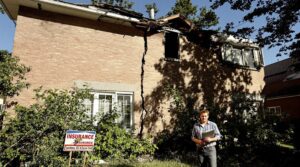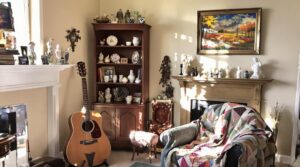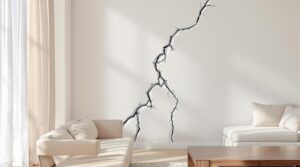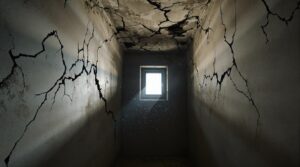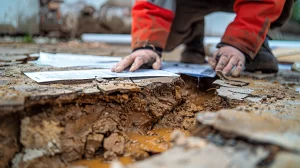Structural damage in homes manifests through several key indicators. Common signs include foundation cracks exceeding 1/4 inch, uneven floors, and bowing walls. Door and window misalignment often signals settlement issues, while water stains and musty odors indicate moisture problems. Exterior warning signs include mortar deterioration, soil separation, and chimney instability. Professional evaluation becomes critical when multiple indicators emerge simultaneously. Understanding these warning signs enables homeowners to address issues before they escalate into major structural failures.
Key Takeaways
- Foundation cracks wider than 1/4 inch, especially horizontal or stair-step patterns in walls, indicate serious structural compromise.
- Doors and windows that stick, won't close properly, or show uneven gaps around frames signal foundation settlement.
- Sagging or uneven floors, accompanied by bouncy spots or protruding nails, suggest joist damage or foundation problems.
- Bowing or leaning walls, visible from inside or outside, require immediate professional evaluation for structural safety.
- Water damage signs, including ceiling stains, musty odors, and pooling around foundations, threaten building structural integrity.
Critical Signs of Foundation Problems
Several critical indicators can reveal underlying foundation problems in residential structures.
Prominent signs of structural issues include cracks exceeding 1/4 inch in walls or ceilings, particularly those displaying horizontal or stair-step patterns.
Foundation settling often manifests through observable gaps around windows and doors, as well as separation between walls and floors.
Uneven floors represent another significant indicator of foundation problems, typically resulting from compromised support systems or deterioration within the foundation structure.
Bowing walls, visible from both interior and exterior perspectives, signal excessive pressure on the foundation that demands immediate professional evaluation.
Additionally, soil movement, specifically when pulling away from the house perimeter, suggests potential drainage issues or foundation instability.
These conditions, when present individually or in combination, indicate serious structural damage that requires thorough assessment to prevent further deterioration and maintain the building's structural integrity.
Visible Wall and Ceiling Warning Signs
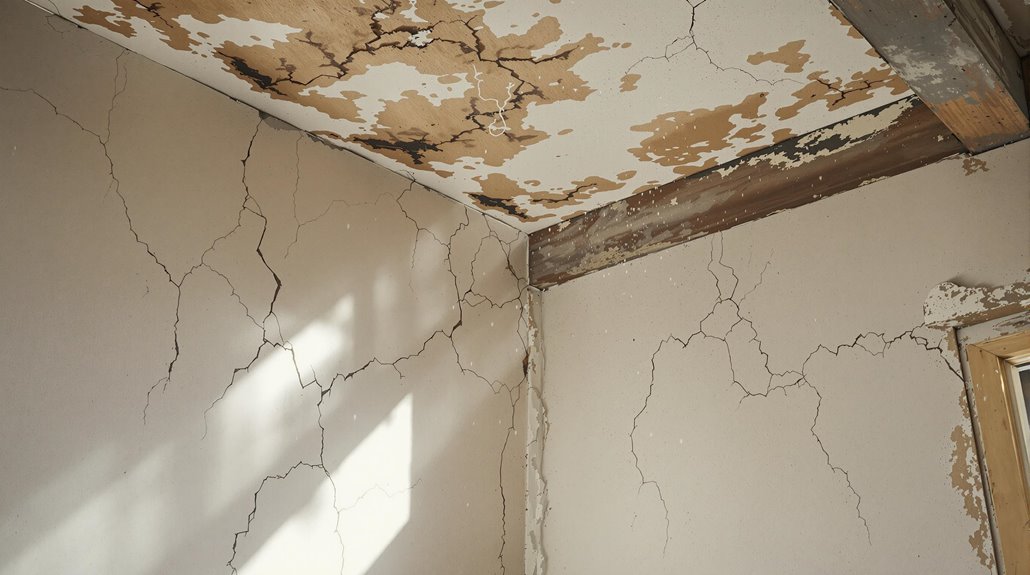
Visual inspection of wall and ceiling surfaces can reveal critical indicators of structural compromise through expanding crack patterns and progressive deterioration.
Sagging ceiling sections, particularly when accompanied by discoloration near joints, often signal compromised structural integrity or moisture-related issues that warrant immediate professional evaluation.
The development and widening of cracks over time, especially those exceeding 1/4 inch or displaying step patterns above doorways, represent significant warning signs of potential structural instability.
Growing Cracks Over Time
Monitoring cracks in walls and ceilings serves as a critical method for detecting potential structural damage in residential buildings. Homeowners should track the progression of cracks, particularly those exceeding 1/4 inch or displaying step patterns above doorways. Horizontal and diagonal cracks often indicate foundational shifts or drainage complications, while hairline cracks typically present lower risks.
| Crack Type | Risk Level | Required Action |
|---|---|---|
| Hairline | Low | Regular monitoring |
| Step Pattern | High | Immediate inspection |
| Horizontal | Severe | Foundation specialist |
| Diagonal | Severe | Structural evaluation |
The presence of growing cracks, especially when accompanied by sagging ceilings or uneven floors, necessitates professional evaluation. Early detection through systematic monitoring can prevent serious issues from developing into costly structural failures that compromise building integrity. Similar to documenting roof damage, taking detailed photographs and documentation of wall cracks over time can strengthen potential insurance claims and professional assessments.
Sagging Ceiling Patterns
Three distinct patterns of ceiling sagging serve as vital indicators of potential structural compromise in residential buildings. Gradual, uniform sagging typically suggests normal settling, while sudden or severe deformation points to moisture damage or rotten beams.
Step-pattern sagging and cracks above doorways indicate severe structural issues often related to shifting foundations.
Water stains frequently accompany sagging ceilings, revealing potential leaks that can accelerate structural deterioration. These visible indicators demand immediate professional inspection to assess the extent of foundation problems and underlying causes.
Early detection through regular monitoring proves essential in preventing extensive damage. Homeowners should document changes in ceiling appearance, particularly noting the progression of sagging patterns, to provide vital information for structural assessment and necessary repairs.
Discoloration Near Joints
Distinct patterns of discoloration near wall and ceiling joints serve as critical warning signs of potential structural compromise in residential buildings.
These visual indicators often manifest as stains or color variations, signaling the presence of moisture intrusion or water damage that can undermine structural integrity over time.
When discoloration appears around joints, it frequently indicates underlying issues such as leaks, poor ventilation, or settling issues within the home's framework.
Left unaddressed, these conditions can foster mold growth and material deterioration.
Regular monitoring of joint areas enables early detection of problems, while the presence of persistent discoloration warrants immediate professional assessment.
A thorough inspection can identify the source of moisture infiltration and determine necessary corrective measures to preserve the building's structural stability.
Door and Window Alignment Issues
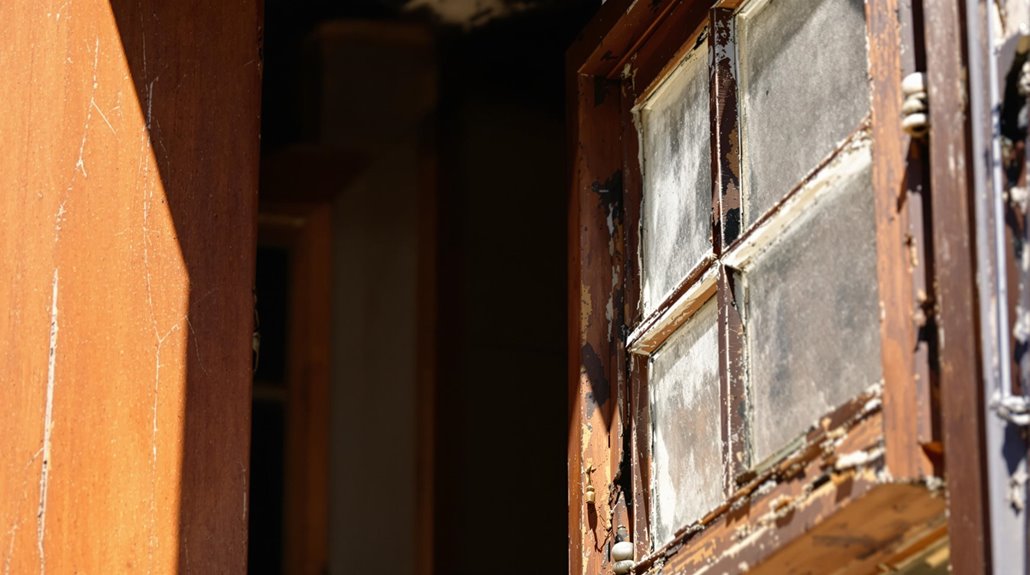
Changes in door and window alignment frequently serve as early indicators of serious structural issues within a home. These manifestations often present as operational difficulties, including sticking frames or improper latching mechanisms. Uneven gaps around door and window frames can signal foundation shifts or structural movement requiring immediate professional evaluation.
| Alignment Issue | Potential Structural Cause |
|---|---|
| Sticking Doors | Foundation Settlement |
| Uneven Gaps | Wall Movement/Bowing |
| Failed Latching | Frame Warping |
| Visible Tilt | Foundation Displacement |
Regular monitoring of door and window functionality is vital for early detection of major structural concerns. When misalignment occurs, prompt investigation can prevent escalation of underlying problems. Professional assessment becomes essential when multiple doors or windows exhibit simultaneous alignment issues, as this pattern may indicate systematic structural deterioration. Addressing these problems early helps maintain both the functionality of doors and windows and preserves the home's structural integrity. Maintaining detailed maintenance records of door and window issues can support future insurance claims and potentially reduce premiums.
Floor Stability and Movement Concerns
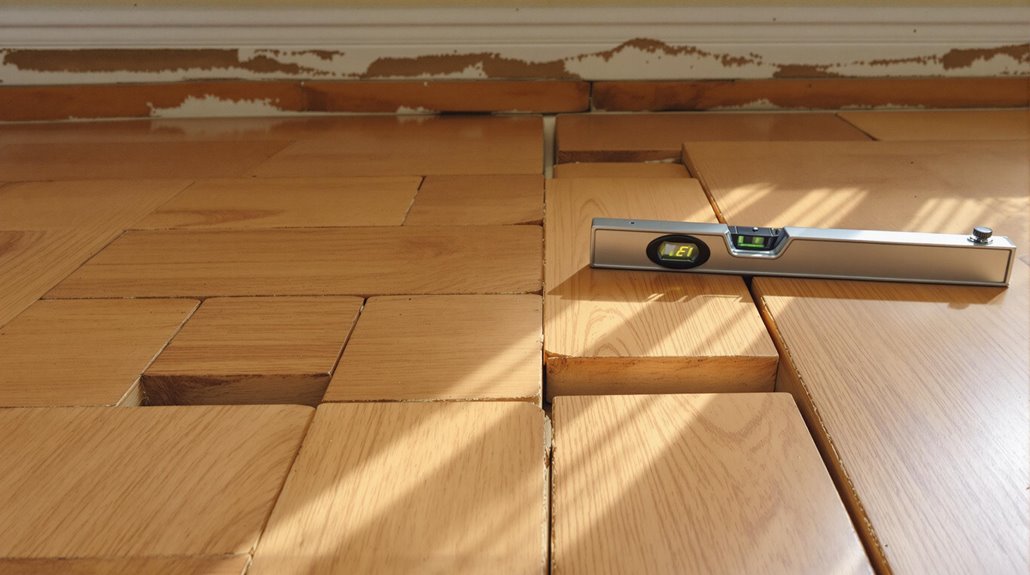
Like misaligned doors and windows, floor stability represents a significant indicator of structural health in residential buildings. When floors exhibit sagging or sloping patterns, these manifestations often indicate substantial foundation movement or compromised support structures that require immediate professional evaluation.
Several key signs warrant attention when evaluating floor-related structural damage in a house. Protruding nails in flooring surfaces may signal improper installation or settlement issues affecting the underlying joists. Floors demonstrating bouncy or springy characteristics frequently indicate potential moisture damage or termite activity, compromising the structural integrity.
Additionally, uneven gaps between floors and walls serve as critical indicators of foundation shifts, often correlating with broader structural instability.
Regular monitoring of floor conditions proves essential for maintaining house structural integrity. Early detection of these signs enables homeowners to address potential problems before they escalate into more severe and costly structural damage, ensuring long-term stability of the residence.
Exterior Structure Warning Indicators
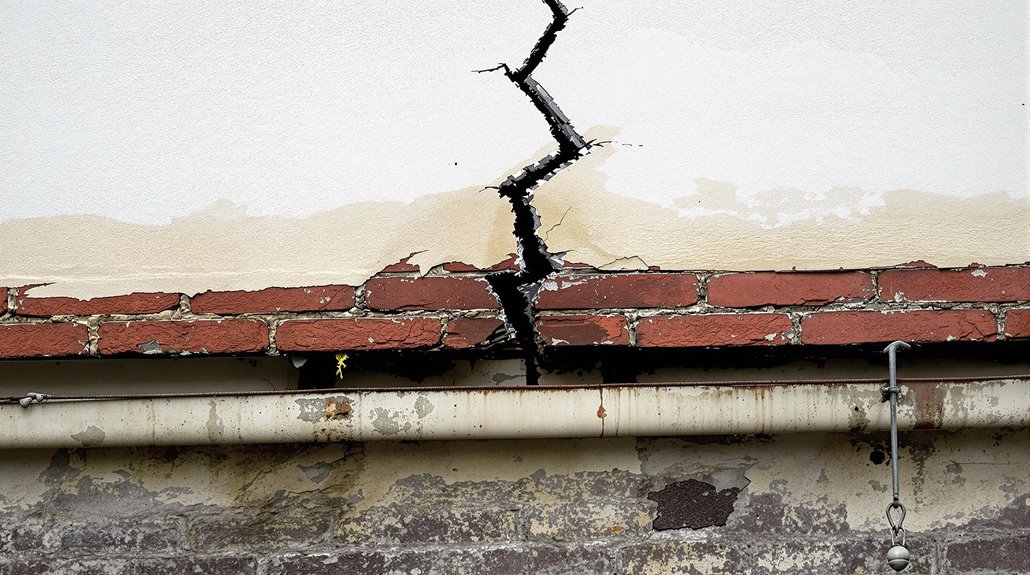
Structural anomalies on a building's exterior often serve as critical indicators of potential damage requiring immediate attention. Observable warning signs include horizontal or stair-step cracks above doorways and windows, which signify significant structural movement.
Foundation problems frequently manifest through soil separation around the building's base, particularly during seasonal changes.
Chimney damage, specifically deteriorating mortar or cracked bricks, indicates underlying structural shifts that warrant investigation. Gaps around windows and doors, coupled with operational difficulties, suggest progressive foundation settlement.
Among the most severe exterior warning signs are bowing or leaning walls, which typically result from moisture intrusion, inadequate drainage, or compromised foundation integrity.
These exterior indicators necessitate professional assessment to determine the extent of structural damage and develop appropriate remediation strategies. Early detection and intervention can prevent catastrophic failure and minimize repair costs while maintaining building stability and occupant safety.
Moisture and Water Damage Patterns
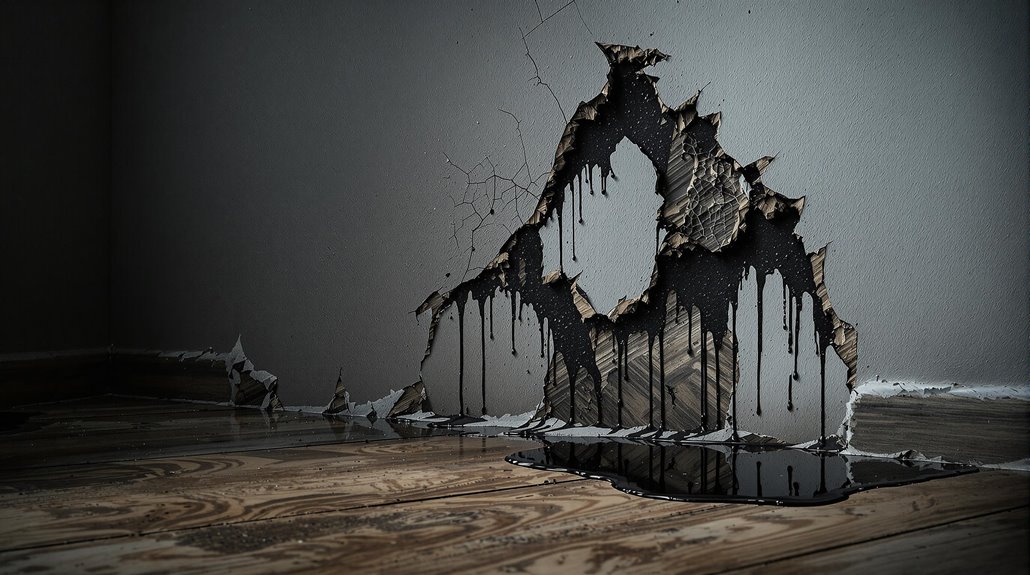
Interior moisture patterns represent one of the most reliable indicators of advancing structural compromise. Ceiling stains often reveal active leaks from compromised plumbing or roofing systems, while bubbling paint and surface deterioration signal moisture trapped within wall cavities.
These manifestations require immediate investigation to prevent escalating structural damage.
Critical warning signs include damp subfloor conditions, which can lead to compromised floor joists and widespread structural instability. The presence of musty odors, particularly in below-grade spaces, indicates potential mold growth that not only threatens building integrity but also poses significant health risks to occupants.
Water pooling around foundation perimeters typically reveals drainage issues that can accelerate foundation settlement and structural deterioration.
Early detection of these moisture damage patterns enables targeted interventions, preventing the cascade of compounding structural failures that often accompany prolonged water exposure.
Since maintenance-related issues are not covered by standard homeowners insurance, addressing water damage promptly is essential to avoid costly out-of-pocket repairs.
Basement and Crawl Space Red Flags
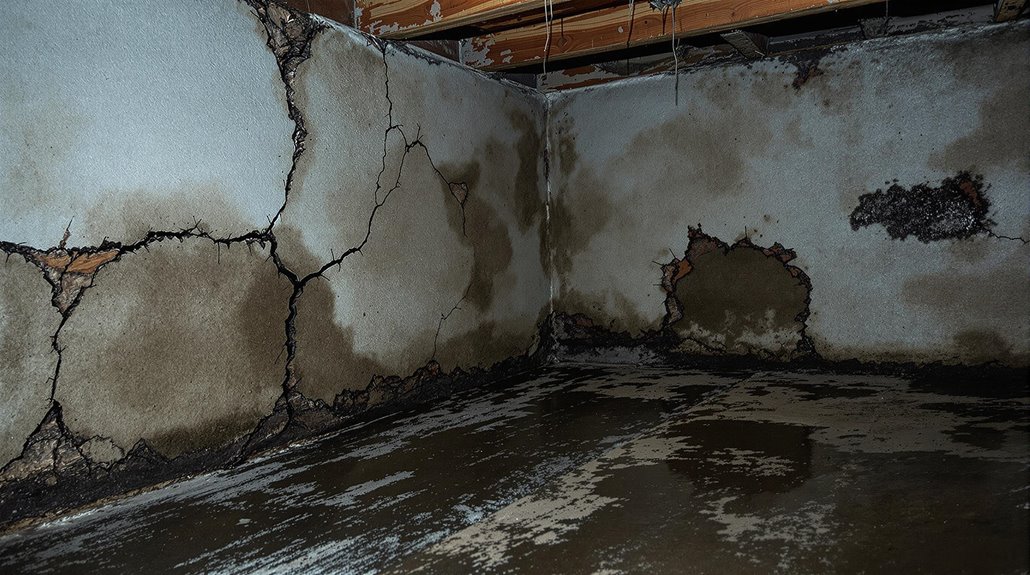
While basement and crawl space areas often remain out of sight, these foundational zones harbor critical indicators of potential structural compromise.
The presence of dampness and musty odors typically signals insufficient ventilation, creating conditions conducive to deterioration. Visible mold growth on walls, floors, or support structures indicates chronic moisture issues that threaten both structural integrity and occupant health.
Standing water or puddles in these spaces reveal serious drainage deficiencies or active leaks that can undermine foundation stability.
Horizontal or diagonal cracks in basement walls and floors suggest foundation problems related to soil pressure and structural movement.
Additionally, corroded pipes serve as evidence of sustained moisture exposure, often pointing to hidden leaks that accelerate structural decay.
These warning signs, when identified early, allow for intervention before minor issues escalate into major structural failures requiring costly repairs.
Roof and Chimney Structural Issues
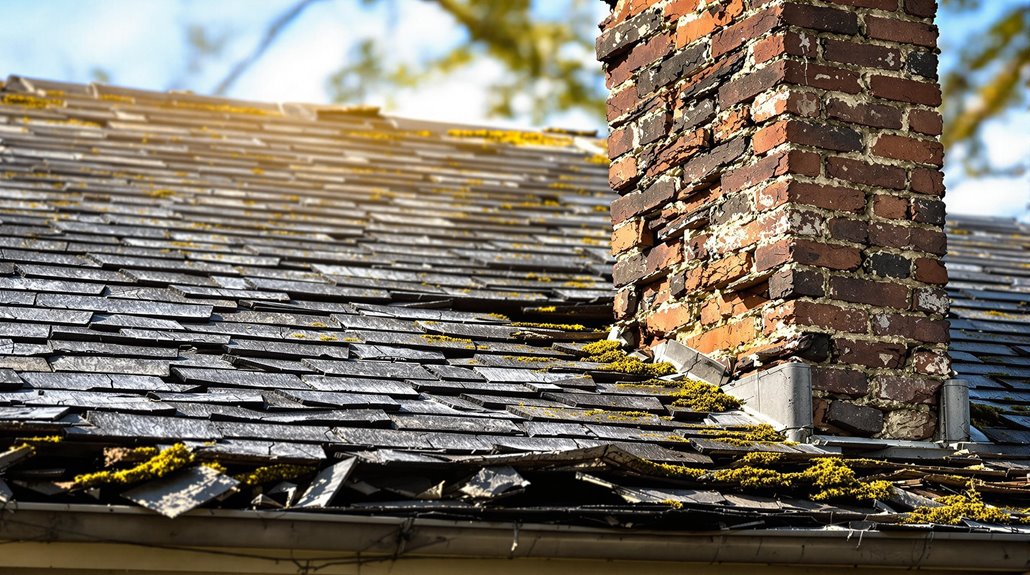
A sagging or uneven roofline serves as a critical indicator of potential structural compromise, often resulting from timber frame movement or improper load distribution.
Chimney cracks, particularly those visible on exterior surfaces, signal foundation shifts and excessive pressure on masonry components that warrant immediate professional assessment.
These structural issues frequently correlate with weather-related deterioration, where moisture infiltration and poor drainage accelerate the degradation of both roof and chimney integrity.
Homeowners facing severe roof or chimney damage should consider consulting public insurance adjusters to ensure proper documentation and maximum claim settlements for structural repairs.
Sagging Roofline Warning Signs
Since rooflines serve as critical indicators of a home's structural health, homeowners should remain vigilant for signs of sagging or uneven slopes along the roof's surface. A sagging roofline often reveals underlying structural issues, typically stemming from weakened rafters or trusses affected by moisture damage.
These problems manifest through uneven roof slopes and compromised water drainage systems. Regular roof inspections can identify early signs of sagging through the detection of water stains and mold in the attic space.
Associated chimney damage, including mortar cracks and brick deterioration, frequently accompanies roofline issues, indicating significant structural shifts. Given the potential for extensive damage and safety risks, professional evaluation becomes essential when these warning signs emerge, as delayed intervention can result in substantial repair costs and compromise home safety.
Securing adequate dwelling coverage helps protect homeowners financially against major structural damage to rooflines and associated components of the home.
Chimney Crack Analysis
Through careful inspection of chimney structures, homeowners can detect critical signs of building stress and potential structural failure. Cracks in mortar joints or brickwork often indicate underlying foundation issues or structural damage requiring immediate assessment.
A leaning or bowing chimney typically signals problematic soil movement or drainage concerns that necessitate professional reinforcement.
Water infiltration through chimney cracks presents a compound threat, accelerating deterioration and potentially fostering mold growth within the structure. These conditions can compromise both the chimney's integrity and the surrounding building components.
Regular professional inspections remain essential for identifying early warning signs of structural instability, as minor cracks can rapidly develop into significant structural concerns.
Early detection and intervention can prevent extensive damage and reduce long-term repair costs.
Frequently Asked Questions
How to Tell if a Home Has Structural Damage?
Structural damage manifests through foundation issues, wall cracks, roof sagging, uneven floors, door misalignment, window gaps, basement leaks, pest infestations, moisture problems, and ceiling blemishes requiring professional assessment.
What Are the Symptoms of Damaged Structures?
Structural damage manifests through cracked walls, sagging ceilings, uneven floors, door misalignment, window gaps, mold growth, peeling paint, basement leaks, roof sagging, and foundation cracks requiring professional assessment.
How Do You Detect Structural Damage?
While visual inspections alone aren't definitive, structural damage manifests through cracked walls, uneven floors, sagging roofs, misaligned doors, sticky windows, mold growth, foundation cracks, bulging ceilings, water damage, and pest infestations.
What Would Be Considered a Structural Red Flag?
Major structural red flags include foundation cracks, uneven floors, wall bulges, ceiling sagging, door misalignment, window gaps, chimney tilting, water intrusion, pest infestations, and persistent moisture damage throughout the structure.
Final Thoughts
Studies indicate that 25% of homes in the United States will experience some form of structural damage during their lifetime. Regular inspection and early detection of these warning signs – from foundation settlement to moisture infiltration – remain essential for maintaining structural integrity and preventing catastrophic failures. Professional assessment of identified issues, combined with prompt remediation, can greatly reduce repair costs and extend a building's serviceable lifespan.
For homeowners experiencing structural damage covered by their homeowners insurance policy, both insurance industry insiders and legal experts strongly advise consulting a qualified state-licensed public adjuster. Public adjusters work exclusively as policyholder advocates, not for insurance companies. These state-licensed professionals help navigate complex insurance policies, identify hidden damages often unknown to policyholders, thoroughly document losses, and negotiate with insurance companies to ensure fair settlements while protecting policyholder rights.
The benefits of hiring a public adjuster include maximized claim payouts, expedited claims processing, and reduced stress during insurance negotiations. Homeowners dealing with property damage or loss claims can request a no-obligation free consultation with a Public Claims Adjusters Network (PCAN) member public adjuster to better understand their options and potential coverage.
